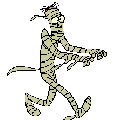I've read the following article a couple of times and it has provided some clarity on the recent court rulings on on the application of NAGPRA itself. I'll spread it over a couple of posts.
"Complex legal legacies: the native American graves protection and repatriation act, scientific study, and Kennewick Man.(Native American Grave Protection and Repatriation Act)." Susan B. Bruning. American Antiquity 71.3 (July 2006): p501(21).
Abstract:
Debates over disposition options for an inadvertently discovered set of early Holocene human remains known as Kennewick Man have fueled discussions about the scientific, cultural, and ethical implications of the anthropological study of human remains. A high-profile lawsuit over Kennewick Man has led to the most extensive judicial analysis to date of the Native American Graves Protection and Repatriation Act (NAGPRA), the primary law affecting access to, and the ultimate disposition of ancient human remains found in the United States. However, despite years of litigation, some key questions remain unanswered. The judicial decisions in Kennewick address important questions about determining Native American status and assessing cultural affiliation under the law. However, the court opinions fail to address the role of scientific study within NAGPRA 's confines. This article examines NAGPRA and concludes that two provisions in the law expressly permit the scientific study of human remains if certain conditions are met. Significantly, Kennewick Man might have qualified for study under NAGPRA even if found to be Native American and culturally affiliated with the claimant tribes, which would have enabled study to proceed from the outset while the parties debated the issues of Native American status and potential cultural affiliation.
Three key terms in the satute whose interpretations have been the source of controversy: Native American, Indian Tribe, and cultural affiliation.
Native American: According the NAGPRA, this is defined as "of, or relating to, a tribe, people, or culture that is indigenous to the United States" (Section 2). To be subject to NAGPRA, human remains must qualify under the statute as Native American" (p.507). That is, it must first be demonstrated that the remains have some demonstrable connection to an existing tribe. The Interior Dept. in its interpretation regarding Kennewick insisted that cultural affiliation to an existing tribe only comes into play when a tribe seeks repatriation, and that "Native American" should be broadly construed to mean any remains from the time before the historically documented arrival of Europeans. Nevertheless, the district and Ninth Ciruit courts both interpreted it differently:
The primary issue debated during the oral hearing was whether all human remains predating documented European contact and found within the U.S. borders should be deemed to be Native American under NAGPRA (Bonnichsen et al. v. United States et al. 2003). In its opinion, the circuit court affirmed the district court's ruling that a finding of Native American status requires evidence of a relationship to a present-day group, ruling that the definition requires evidence that remains share "special and significant genetic or cultural features with presently existing indigenous tribes, peoples, or cultures" (Bonnichsen et al. v. United States et al., Ninth Circuit Court of Appeals, No. 02-35996, 2004 U.S. App. LEXIS 1656 [February 4]:1608). . . NAGPRA does not specify with any particularity how Native American status must be determined. The Interior Department and SAA approached the matter by presuming that, for the purposes of NAGPRA, any human remains predating documented European contact that are found within the country's borders would qualify under the law as Native American. From a legal standpoint, such a presumption would place the burden of proof on a party challenging the Native American status of precontact remains, by requiring it to prove that the remains are not Native American. In contrast, the Kennewick courts determined that Congress intended to require proof of Native American status for all remains, regardless of age, in order for NAGPRA to apply. The courts' rulings place the burden of proof squarely on the shoulders of a party claiming that remains are Native American. As a result, both courts required proof of Kennewick Man's status as a Native American before applying NAGPRA to the case, and they both ruled that the government failed to provide sufficient evidence to satisfy its burden. (p. 508)
This is, as we argued earlier, the basis of the "or was" legislation: it would bypass the two court' limitation of only applying NAGPRA after affiliation to an extant tribe had been established.
Cultural Affiliation: NAGPRA defines cultural affiliation as "a relationship of shared group identity which can be reasonably traced historically or prehistorically between a present day Indian tribe or Native Hawaiian organization and an identifiable earlier group" (Section 2)" (p. 509) and provides several categories of evidence that may be used to determine such. As Bruning notes, it is notoriously difficult to define (let alone establish) group identity through time:
Group identity is continually shaped and altered in a variety of ways (Cohen 1978). It is multiscalar in nature, historically contingent, and differentially perceived by group members and nonmembers (Dongoske et al. 1997). (p. 509)
Determination of cultural affinity is accomplished by whatever agency holds the remains; thus, no rigid standards apply. Obviously, cultural affinity is far more difficult to assess the more ancient the remains are, and this was the main issue behind Kennewick. In this case, the close geographic proximity of the remains and the claimants' historical ocupancy was not sufficient to establish shared group identity nor was evidence of oral tradition on the part of the claimants. Interestingly, the district court found that
NAGPRA does not mandate that every set of remains be awarded to some tribe, regardless
of how attenuated the relationship may be. On the contrary, the Act expressly contemplates instances in which no claimant can establish the requisite degree of cultural affiliation to be entitled to claim the remains" (p.512)
Thus, as it stands, NAGPRA only applies after cultural affiliation to an extant group can be established.
Except, and this was noted in an earlier post, "NAGPRA grants tribal control over the disposition of newly discovered Native American human remains that are culturally unidentifiable if they are found on the tribe's land (Section 3[a][2][A]) or if they are found on land that has been recognized by final court judgment to be the aboriginal land of the tribe, and the tribe states claim (Section 3[a][2][C])" (p.512)
This second part was the "loophole" that an earlier commenter was noting: If the "or was" clause was added, even if no cultural affiliation to extant groups is established, defining "Native American" as any group here before the arrival of Europeans would mean that 3[a][2][C] wold apply. This may not be the case, IMO. The statute as quoted above seems plainly worded to refer to existing tribes only, and as the courts have already established, simple geographic proximity is not sufficient to establish cultural affiliation. Hence, it may not have been an issue anyway.





